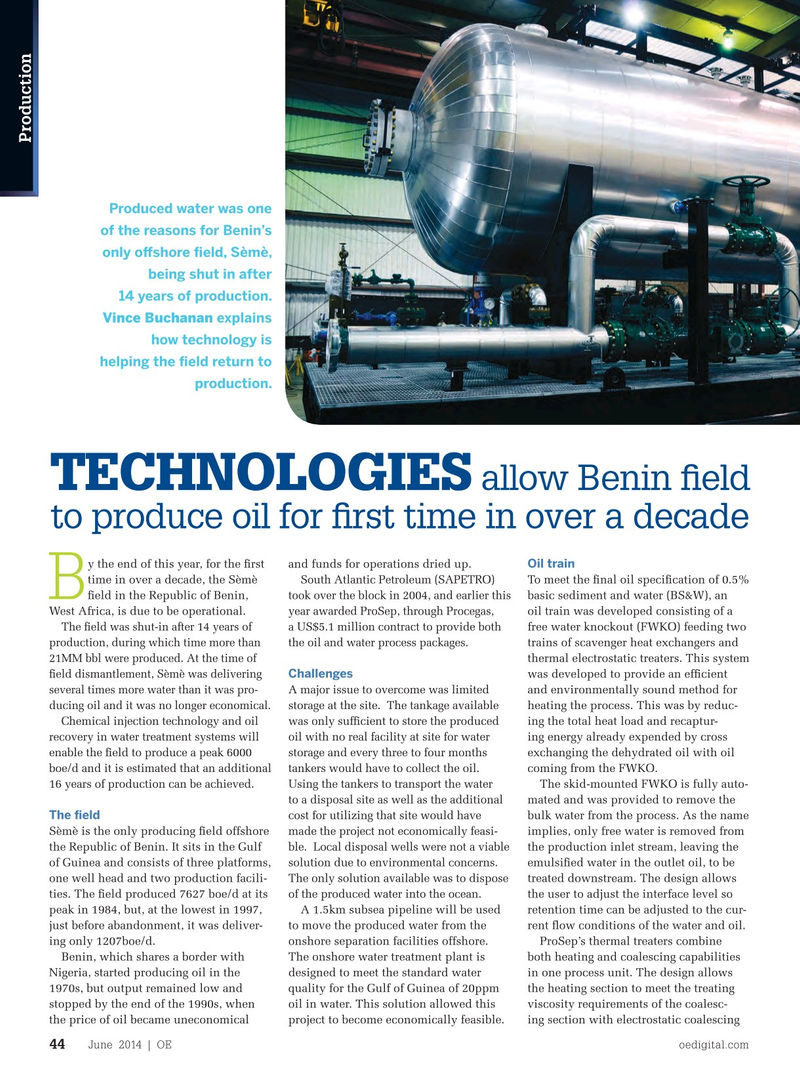
Page 42: of Offshore Engineer Magazine (Jun/Jul 2014)
Read this page in Pdf, Flash or Html5 edition of Jun/Jul 2014 Offshore Engineer Magazine
Production
ProdOps-3-fg1 – ProdOps-3-fg2 – Photo from PWA ProSep.
ProdOps-3-fg3 – (might not be able to use due to the detail. But that’s fne).
ProdOps-3-fg4 - Vince Buchanan, ProSep Oil Technology Manager
Produced water was one of the reasons for Benin’s only ofshore feld, Sèmè, being shut in after 14 years of production.
Vince Buchanan explains how technology is helping the feld return to production.
TECHNOLOGIES allow Benin feld to produce oil for frst time in over a decade y the end of this year, for the frst and funds for operations dried up.
Oil train
South Atlantic Petroleum (SAPETRO) time in over a decade, the Sèmè To meet the fnal oil specifcation of 0.5%
B took over the block in 2004, and earlier this feld in the Republic of Benin, basic sediment and water (BS&W), an year awarded ProSep, through Procegas,
West Africa, is due to be operational. oil train was developed consisting of a
The feld was shut-in after 14 years of a US$5.1 million contract to provide both free water knockout (FWKO) feeding two production, during which time more than the oil and water process packages. trains of scavenger heat exchangers and 21MM bbl were produced. At the time of thermal electrostatic treaters. This system
Challenges feld dismantlement, Sèmè was delivering was developed to provide an effcient
A major issue to overcome was limited several times more water than it was pro- and environmentally sound method for storage at the site. The tankage available ducing oil and it was no longer economical.
heating the process. This was by reduc-
Chemical injection technology and oil was only suffcient to store the produced ing the total heat load and recaptur- recovery in water treatment systems will oil with no real facility at site for water ing energy already expended by cross enable the feld to produce a peak 6000 storage and every three to four months exchanging the dehydrated oil with oil boe/d and it is estimated that an additional tankers would have to collect the oil. coming from the FWKO. 16 years of production can be achieved. Using the tankers to transport the water
The skid-mounted FWKO is fully auto- to a disposal site as well as the additional mated and was provided to remove the
The feld cost for utilizing that site would have bulk water from the process. As the name
Sèmè is the only producing feld offshore implies, only free water is removed from made the project not economically feasi- ble. Local disposal wells were not a viable the Republic of Benin. It sits in the Gulf the production inlet stream, leaving the solution due to environmental concerns. of Guinea and consists of three platforms, emulsifed water in the outlet oil, to be
The only solution available was to dispose one well head and two production facili- treated downstream. The design allows of the produced water into the ocean.
ties. The feld produced 7627 boe/d at its the user to adjust the interface level so peak in 1984, but, at the lowest in 1997, A 1.5km subsea pipeline will be used retention time can be adjusted to the cur- just before abandonment, it was deliver- to move the produced water from the rent fow conditions of the water and oil. ing only 1207boe/d. onshore separation facilities offshore. ProSep’s thermal treaters combine
Benin, which shares a border with The onshore water treatment plant is both heating and coalescing capabilities
Nigeria, started producing oil in the designed to meet the standard water in one process unit. The design allows 1970s, but output remained low and quality for the Gulf of Guinea of 20ppm the heating section to meet the treating stopped by the end of the 1990s, when oil in water. This solution allowed this viscosity requirements of the coalesc- the price of oil became uneconomical project to become economically feasible. ing section with electrostatic coalescing
June 2014 | OE oedigital.com 44 044_OE0614_ProdOps3-PWA.indd 44 5/22/14 9:29 PM

 41
41

 43
43